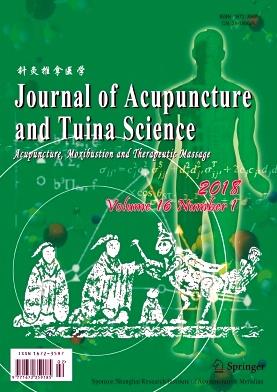传统功法结合手法治疗下颈段颈椎间盘突出症的疗效观察
IF 0.5
4区 医学
Q4 INTEGRATIVE & COMPLEMENTARY MEDICINE
引用次数: 0
摘要
摘要目的观察传统气功配合推拿手法治疗下颈椎间盘突出症的疗效。方法将符合纳入标准的CDH患者120例随机分为观察组和对照组,每组60例。两组患者均给予相同的推拿手法。观察组进行传统气功运动,对照组进行常规颈部运动。治疗8周后,观察两组疗效。治疗结束后3个月随访,记录复发情况。结果观察组总有效率高于对照组(P <0.05)。观察组患者症状评分改善程度显著高于对照组(P <0.05)。部分颈肌横截面积及脂肪浸润比较,组间差异有统计学意义(P <0.05)。观察组复发率低于对照组(P <0.05)。结论在相同推拿手法治疗的基础上,传统气功运动治疗CDH的疗效优于常规颈部运动,对疼痛和生活质量的改善更为显著,复发率更低。本文章由计算机程序翻译,如有差异,请以英文原文为准。
传统功法结合手法治疗下颈段颈椎间盘突出症的疗效观察
Abstract Objective To observe the efficacy of traditional Qigong exercise combined with Tuina (Chinese therapeutic massage) manipulations in treating lower cervical disc herniation (CDH). Methods A total of 120 CDH patients who met the inclusion criteria were randomly divided into an observation group and a control group, with 60 cases in each group. Patients in both groups were given the same Tuina manipulations. In addition, patients in the observation group practiced traditional Qigong exercise, and those in the control group did conventional neck exercise. After 8 weeks of treatment, the efficacy of the two groups was observed. Follow-up was conducted 3 months after the end of the treatment to record any recurrence. Results The total effective rate of the observation group was higher than that of the control group ( P <0.05). The improvement in symptom scores was more significant in the observation group than in the control group ( P <0.05). There was inter-group statistical significance in comparing the cross-sectional area and fatty infiltration of certain cervical muscles ( P <0.05). In addition, the recurrence rate in the observation group was lower than that in the control group ( P <0.05). Conclusion On the basis of the same Tuina manipulation treatment, the efficacy of traditional Qigong exercise in treating CDH is superior to that of conventional neck exercise, with more significant improvements in pain and quality of life and a lower recurrence rate.
求助全文
通过发布文献求助,成功后即可免费获取论文全文。
去求助
来源期刊

Journal of Acupuncture and Tuina Science
INTEGRATIVE & COMPLEMENTARY MEDICINE-
CiteScore
0.60
自引率
40.00%
发文量
55
期刊介绍:
Journal of Acupuncture and Tuina Science (ISSN 1672-3597, CN 31-1908/R) is a journal with an international scope, focusing on the popularization of traditional Chinese medicine and acupuncture- moxibustion culture, the promotion of international exchanges and the prosperity of clinical Chinese medicine and acupuncture-moxibustion. Journal of Acupuncture and Tuina Science mainly involves clinical practice and emphasizes the presentation of the detailed methods of observing and treating clinical common diseases on which acupuncture-moxibustion has a good effect. The articles are characterized by practicality, briefness and reproducibility. The main contents include the experiences of senior TCM doctors, forum on special diseases, clinical reports, brief reports, education series, terminology and brief introduction to new books. Communications regarding Academy activities are also appropriate.
 求助内容:
求助内容: 应助结果提醒方式:
应助结果提醒方式:


